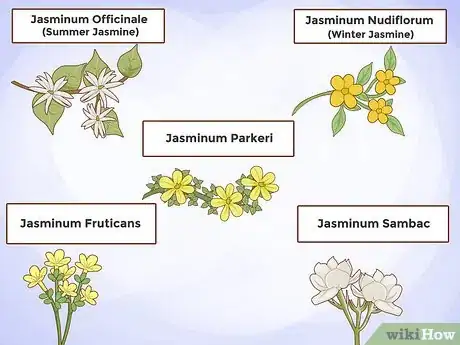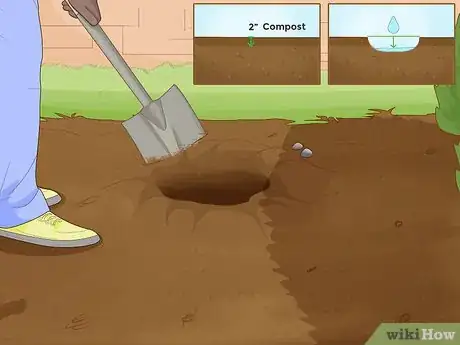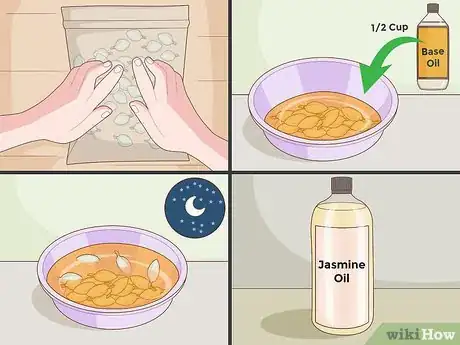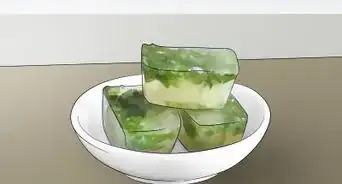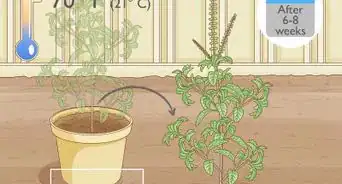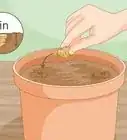This article was co-authored by Melinda Meservy. Melinda Meservy is a Plant Specialist and the Owner of Thyme and Place, a botanical boutique offering plants and gifts in Salt Lake City, Utah. Before starting her own business, Melinda worked in process and business improvement and data analytics. Melinda earned a BA in History from the University of Utah, is trained in lean and agile methodologies, and completed her Certified Professional Facilitator certification. Thyme and Place offers indoor plants and containers, a fully stocked potting bench, and tips on plants to suit your space and lifestyle.
There are 10 references cited in this article, which can be found at the bottom of the page.
wikiHow marks an article as reader-approved once it receives enough positive feedback. This article received 12 testimonials and 92% of readers who voted found it helpful, earning it our reader-approved status.
This article has been viewed 811,616 times.
Starry jasmine flowers have an exotic, sweet fragrance that permeates the air on warm summer evenings. They bloom all summer on either vines or shrubs, depending on the cultivar. The flower buds can be harvested to make a fragrant, restorative tea. See Step 1 and beyond to learn how to plant, care for and harvest jasmine.
Steps
Planting Jasmine
-
1Choose a cultivar to grow. There are over 200 species of jasmine, each with different characteristics. Some are evergreen, while some are deciduous. Some take the form of vines, while others are shrubs. Some are so tender that they must be grown indoors, while others are frost hardy. Buy the jasmine cultivar that's right for your needs. You'll find jasmine plants available in pots at the nursery, or you can order seeds online. These jasmines are the most commonly available in nurseries:
Jasmine Cultivars Variety Growing Requirements Characteristics Jasminum officinale (summer jasmine) Full sun to partial shade; grows outdoors in mild climates; otherwise indoor
White, starry flowers; frost hardy vine popular in many regions.
Jasminum nudiflorum (winter jasmine) Full sun to partial shade; grows outdoors in most regions
Yellow flowers; low maintenance; makes good groundcover
Jasminum parkeri Full sun to partial shade; grows outdoors in mild climates; otherwise indoor
Yellow flowers; grows as a shrub.
Jasminum fruticans Full sun to partial shade; grows outdoors in mild climates; otherwise indoor
Yellow, tubular flowers; evergreen shrub.
Jasminum sambac Full sun to partial shade; grow indoors unless in tropical climate
Fragrant flowers make delicious tea; requires controlled indoor environment in most regions.
-
2Find a suitable spot for your jasmine plant. Each jasmine cultivar has specific environmental needs, so do a little research to find out what conditions you need to provide for your plant. In order for your jasmine to thrive, it's necessary to provide the right level of sun and the proper temperature. When you're deciding where to plant your jasmine, take the following variables into account:
- What level of sun does it need? Most jasmine plants require partial to full sun, although a few cultivars accept full shade.
- Is it hardy in your climate? Determine whether the jasmine you have chosen will thrive outdoors or if it would be better off in a pot inside, where you can control the temperature and humidity. If you're planting outside, you'll want to choose the warmest spot you can find.
- How much space does your jasmine plant need? Some cultivars are vines that grow up walls and fences, others grow along the ground and provide good ground cover, and still others grow as contained shrubs. Pick a planting spot that suits the type you have.
Advertisement -
3Prepare the soil for planting. Most jasmine cultivars do best in rich, well-draining soil. Whether you're planting your jasmine in the ground or in a pot, prepare the soil by working in in 2-inch layer of compost. This will ensure that the jasmine produces healthy flowers throughout the growing season.
- If you're planting outside, check the spot you've chosen to make sure it drains well. Dig a hole and fill it with water. If the water quickly soaks into the hole and leaves it empty, the soil there drains well. If the water sits and drains slowly, choose a different planting spot.
-
4Plant the jasmine. Slide the jasmine plant gently from its container and water the root ball. Tickle the roots by gently scratching them all over. Dig a hole twice the size of the root ball and set the jasmine plant inside. Leave the soil around the hole a little taller than the soil level of your plant, creating a reservoir for water. Lightly pat soil around the base of the jasmine plant to hold it in place. Water the soil around the base well to help the plant settle. Add more soil if necessary to keep the jasmine erect.
- While the most common way to plant jasmine is to buy a young jasmine plant, it is also possible to start jasmine from seed. Jasmine seeds have a low germination rate and require special care according to the cultivar. In most cases, you can start the seeds indoors in seed pots filled with seed starter mix, then harden off the seedlings and plant them outside once the last frost has passed.
- Another way to plant jasmine is to use semi-ripe cuttings taken from a mature jasmine plant. In mid-summer or fall, cut healthy 6-inch stems from a jasmine plant. Prepare a pot with a soil and compost mixture and push the stems into a pot. Overwinter the pot in a sunny window, keeping it well watered, and transplant it in the spring.
Caring for Jasmine
-
1Provide stakes for climbing jasmine. Many varieties of jasmine require stakes to climb in order to grow strong and healthy. Place a tall stake or a trellis a few inches from the base of the jasmine, and gently wrap it around the stake as it grows. Eventually, it will begin growing up the stake on its own. If you planted the jasmine next to a wall or fence, train it to grow upward until it begins growing on its own.
- To ensure that the jasmine establishes itself on the trellis or stake, you can use string or twine to loosely tie the talks to the support. Remove the ties when the vine is established.[1]
-
2Keep the environment moist. Water the soil around the jasmine throughout the growing season to keep it moist, but not soggy. A good rule of thumb for determining when the water jasmine is to water when the soil begins to look and feel a little dry. Use the finger test - stick your index finger 2 inches (5.1 cm) into the soil; if it’s dry, water the soil. If your jasmine is in a pot, be sure it's draining adequately and water once a day.
- Water jasmine from the bottom to keep from getting the leaves wet. The sun will burn the leaves if water droplets remain on them during the sunniest hours.[2]
- For jasmine you're growing indoors, be mindful of the humidity level of the air as well as the moisture of the soil. Tender varieties of jasmine need a humidity level of between 30 and 45. Use a humidifier or spray the plant with mist frequently.[3]
-
3Fertilize the jasmine once a month. During the growing season, fertilizing the jasmine once a month will keep it blooming. Sprinkle a balanced fertilizer that is water soluble around the base of the jasmine, or use a diluted liquid fertilizer.
- Alternatively, you can side-dress the jasmine with compost by working an inch of compost into the soil around the base of the jasmine plant. Be careful not to disturb the roots.
- Top-dressing works also; when you water, it takes the nutrients from the compost down into the soil.
-
4Prune the jasmine.[4] Throughout the growing season, remove dead leaves, flowers and stems by pinching them off or using hand pruners to make a cut flush with the main stem of the plant. Tidy the plants by pruning stray stems. By strategically removing stems here and here, you can control the shape of the vine. Shrub jasmine and varieties grown indoors will need less pruning to maintain their shape.
- Don't prune before or during the blooming period, as this can inhibit blooming. Wait until the plant has finished blooming for the season.[5]
- To improve the shape of shrub-like jasmine, you can cut the stems back by a third after blooming. The shrub will come back next season with a fuller shape.[6]
-
5Mulch the jasmine in the fall and summer. In order to protect the jasmine plants over the winter, add a few inches of pine straw, manure or garden compost around their bases. This will ensure that the root systems don't freeze completely, and your jasmine should begin growing again when the weather warms. In the summer, do the same to help conserve water and manage soil temperature.
- If you have been growing your jasmine in a pot outside, you can bring it indoors for the winter rather than adding mulch.
- Jasmine grown indoors year-round does not require mulching. However, it's important to keep them in a sunny room with a constant temperature of between 60 and 75 degrees.[7]
-
6Watch for pests. While jasmine generally isn't bothered by pests, it's still a good idea to watch out for certain insects that might affect its growth. If you see the following insects on your jasmine, pick them off by hand and place them in a jar of soapy water, or wash the leaves of the jasmine with a soapy water solution.[8] You can also use a solution of water and neem oil:
- Aphids
- Mealybugs
- Red spider mite
- Soft scales
-
7Bring back blooms. If your jasmine plant has bushy green growth but no blossoms, you may have too much nitrogen in your soil, which often happens due to over-fertilizing. Alternatively, your plant may be stressed due to issues like over- or under-watering, extreme temperatures, insufficient light, or stagnant air.
- Indoor jasmine also needs to rest each fall.[9]
Harvesting Jasmine
-
1Cut jasmine to put on display. A jasmine vine or shrub will produce many flowers throughout the season, and you may want to bring some indoors to display as part of an arrangement. Use a sharp pair of pruners to cut branches loaded with flowers and leaves. Place the stems in water right away to preserve their freshness.[10]
-
2Harvest jasmine buds to make tea. When your jasmine produces flowers in the spring and summer, you can make your very own jasmine tea from the flower buds. Jasmine tea is said to have restorative properties, especially when mixed with green tea leaves.[11] To make your own, follow these steps:
- In the early morning, gently pick flower buds from the plant. Their essence is strongest at this time of day.
- Place them in a single layer on a baking tray.
- Bake the buds using your oven's lowest setting - 200 °F (93 °C) or lower. You may also dry the buds by placing them in a sunny window in a dry room.
- Let the buds completely dry. In the oven, it will take about 3 hours. Be sure not to overcook them.
- Let the buds sit overnight on the tray before storing them.
- Store the buds in an airtight jar. When you want to make tea, add a tablespoonful to boiling water. Let it the tea steep for 4 minutes, then strain out the buds and enjoy.
-
3Use jasmine buds to make infused oil. If you want to harness the strong, sweet fragrance of jasmine to use as perfume, you can make your own infused oil with fresh buds. You'll need a glass jar with a tight-fitting lid and a base oil of your choice. Almond, jojoba, olive, or castor oil are all good options.[12] Follow this process to make the infusion:
- Harvest 1/4 cup of fresh buds in the morning.
- Put the buds in a plastic bag and tap them gently with a hammer to release their oils.
- Place the buds in the jar and pour 1/2 cup of base oil over them. Seal the jar and leave it in a cool, dark place for 24 hours.
- Strain the buds and smell the oil. If you want a stronger oil, repeat the process with fresh buds. Continue steeping fresh buds in oil until the scent is as strong as you want it to be.
- Transfer the oil to an amber or blue glass bottle for long-term storage. You can dab on the oil and use it as perfume, or use the fragrant oil as an ingredient in lotion, lip balm and other concoctions.
Expert Q&A
Did you know you can get expert answers for this article?
Unlock expert answers by supporting wikiHow
-
QuestionWhat should I do if the blooms died on my Jasmine plant?
 Melinda MeservyMelinda Meservy is a Plant Specialist and the Owner of Thyme and Place, a botanical boutique offering plants and gifts in Salt Lake City, Utah. Before starting her own business, Melinda worked in process and business improvement and data analytics. Melinda earned a BA in History from the University of Utah, is trained in lean and agile methodologies, and completed her Certified Professional Facilitator certification. Thyme and Place offers indoor plants and containers, a fully stocked potting bench, and tips on plants to suit your space and lifestyle.
Melinda MeservyMelinda Meservy is a Plant Specialist and the Owner of Thyme and Place, a botanical boutique offering plants and gifts in Salt Lake City, Utah. Before starting her own business, Melinda worked in process and business improvement and data analytics. Melinda earned a BA in History from the University of Utah, is trained in lean and agile methodologies, and completed her Certified Professional Facilitator certification. Thyme and Place offers indoor plants and containers, a fully stocked potting bench, and tips on plants to suit your space and lifestyle.
Plant Specialist
-
QuestionIf my star jasmine has several seed pods, will those hinder the plant growth and, if so, should I remove them?
 Katie GohmannKatherine Gohmann is a Professional Gardener in Texas. She has been a home gardener and professional gardener since 2008.
Katie GohmannKatherine Gohmann is a Professional Gardener in Texas. She has been a home gardener and professional gardener since 2008.
Professional Gardener
-
QuestionWhat type of fertilizer is used for a jasmine plant?
 Katie GohmannKatherine Gohmann is a Professional Gardener in Texas. She has been a home gardener and professional gardener since 2008.
Katie GohmannKatherine Gohmann is a Professional Gardener in Texas. She has been a home gardener and professional gardener since 2008.
Professional Gardener
Things You'll Need
- Jasmine plant(s)
- Garden shovel
- Gardening gloves
- Compost
- Trowel
- Plastic garden plant ties
- Pine straw
References
- ↑ http://homeguides.sfgate.com/grow-jasmine-shade-48974.html
- ↑ http://www.gardeningknowhow.com/ornamental/flowers/jasmine/growing-jasmine-plants.htm
- ↑ http://www.gardeners.com/how-to/how-to-overwinter-tender-plants/5019.html
- ↑ Melinda Meservy. Plant Specialist. Expert Interview. 18 August 2020.
- ↑ http://homeguides.sfgate.com/prune-potted-jasmine-33179.html
- ↑ http://homeguides.sfgate.com/prune-potted-jasmine-33179.html
- ↑ http://www.gardeners.com/how-to/how-to-overwinter-tender-plants/5019.html
- ↑ Melinda Meservy. Plant Specialist. Expert Interview. 18 August 2020.
- ↑ https://www.gardeningknowhow.com/ornamental/flowers/jasmine/non-flowering-jasmine.htm
- ↑ http://www.gardeningknowhow.com/ornamental/flowers/jasmine/growing-jasmine-plants.htm
- ↑ http://healthyeating.sfgate.com/health-benefit-jasmine-tea-10533.html
- ↑ http://www.savvyhomemade.com/make-your-own-essential-oil/
- ↑ Melinda Meservy. Plant Specialist. Expert Interview. 18 August 2020.
- http://hortchat.com/info/jasmine-polyanthum
- http://www.brighterblooms.com/planting-directions/jasmine-vine-care/
About This Article
To grow jasmine, plant in rich, well-draining soil in a location that gets partial to full sun. Keep the soil around the jasmine moist during the growing season and fertilize your plants once per month to encourage more blooms. Remove dead leaves and pinch off spent flowers to keep your jasmine in good shape, and don't forget to add a few inches of mulch around the plants each fall to protect them upcoming winter temperatures! For tips on harvesting your jasmine, read on!
